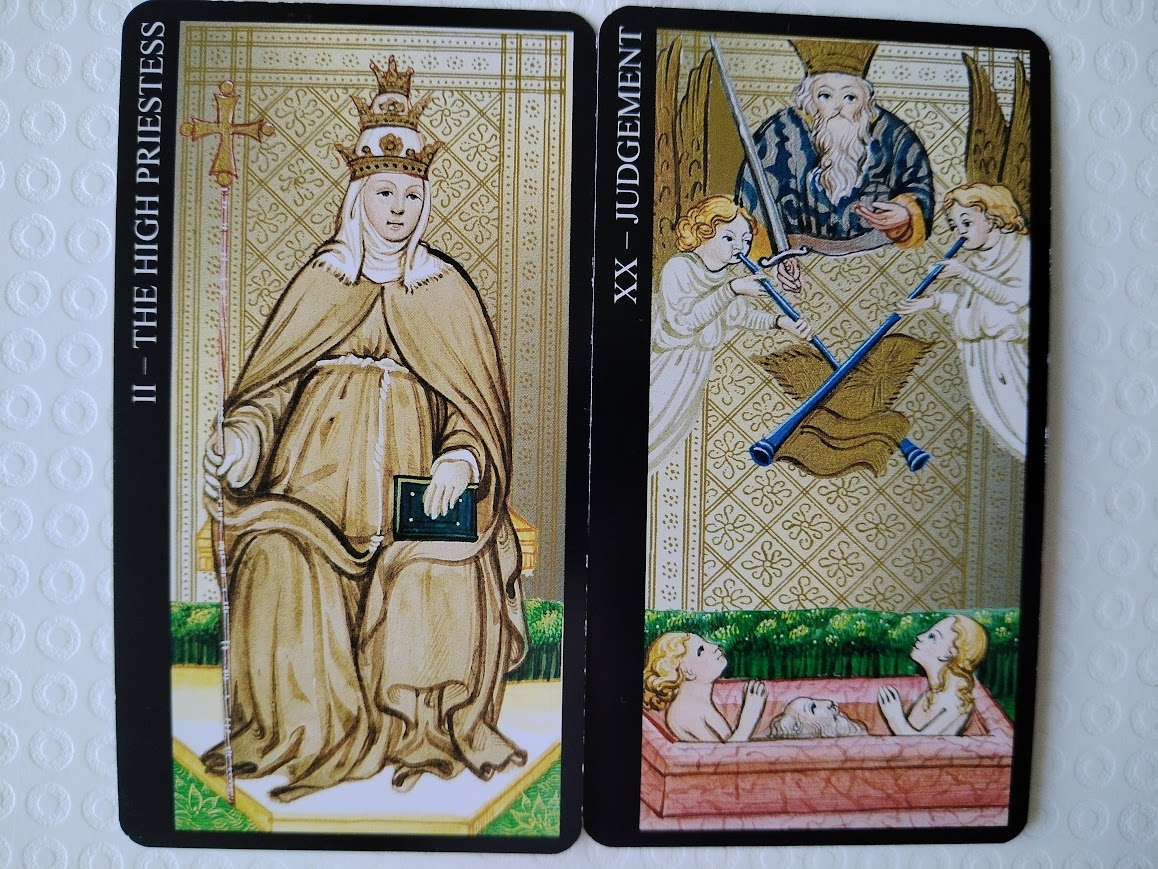One of the oldest Tarot decks preserved to this day, perhaps the most beautiful of all. These cards are universally recognized as one of the most extraordinary examples of the art of miniature and Renaissance symbolism.
For the first time, the Visconti Tarot has been restored and printed with gold foil impressions, to enhance their original splendor.
As a Total Tarot deck, there's no unboxing video, but you can watch the flickthrough on Tiktok, and there's a sample spread using the deck.
The Visconti tarot deck - or, to give it it's full name, the Visconti-Sforza deck - is one of the oldest, most complete decks we know about. It was created in Italy about the 1450s for the Duke of Milan. Each card featured gold leaf in the background and details and some characters were based on the Duke and his family, and the deck as a whole was horrifically expensive, costing more than most houses at the time. (Tarot at the time was a specific kind of card game, with no divinatory applications.) 74 of the 78 cards still exist, giving us an amazing window into life at the time. Lo Scarabeo have recreated the deck, filling in the four missing ones using this and other decks from the same period as references.
Overview of the Deck
This is a standard, 78 card deck. As a TT deck I can't comment on the Little White Book or the original box, but the magazine does offer a look into the history of it.
Artwork and Design
The artwork looks old fashioned to modern eyes, and it's quite overtly religious, but it is a fascinating look at the artwork popular at the time.
One interesting thing is that almost all the characters look quite young, including the Kings. The Emperor and Hierophant are elderly, though, retaining the idea of wisdom gained with age for those cards. The cards use a limited palette, but it works for them.
The cards feature this, reversible back image:
Symbolism and Interpretation
One thing to note is that this is a pip deck, so the Minors aren't illustrated. This type of deck is often harder for beginners as there are no clues to the cards' meanings.
The Majors are standard RWS and could be read by anyone who knows that deck. It's interesting to see how the images have altered over the years while still being very readable! For instance, the Death card, usually shown with Death on a horse overlooking some people, here has Death in his older manifestation as a Reaper.
Ease of Use
I found this deck took a little getting used to, but it gives good readings; I used a mix of daily cards and more in depth spreads and it did well on both. As mentioned above, pip decks are always a little harder (at least for me), but once I adapted to the deck I found it was honest and forthright.
Personal Connection
My Querants found the readings good and to the point. One disliked the overtly religious images; the other didn't mind that, and in fact liked the colors, but disliked the pips. So it's a tricky deck! They did both say that the readings were accurate and easy to understand, though. I think this would be a good deck for a daily draw or quick check-in read, maybe not the more complicated readings.
Strengths
- It's accurate and to the point
- I only had to think hard about one card; all the other meanings were obvious and clear
- The golden backgrounds make the cards bright and cheerful, even in traditionally 'dark' cards
Weaknesses
- Pips can be difficult for beginners
- The art is old-fashioned and religious and won't suit all readers or querants
Conclusion
I think if I had tried this deck earlier in my tarot practice I'd have a different opinion, but with some knowledge under my belt I was able to understand it better. It is, objectively, very beautiful and I imagine the originals, with their real gold, must be an astounding sight. I wouldn't recommend this for complete beginners, only because of the pips; but for anyone with an interest in the history of Tarot, or an interest in beautiful cards, this is a must have.
Further Reading/Viewing
A couple of other Tarot publishers have recreated the deck, meaning that the four missing cards would vary from each other just slightly which would be an interesting study! For similar pip decks, any Marseille style will do. You can also learn about the history of the Visconti Sforza family.












No comments:
Post a Comment